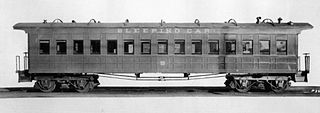
The sleeping car or sleeper is a railway passenger car that can accommodate all passengers in beds of one kind or another, for the purpose of sleeping. George Pullman was the American innovator of the sleeper car.
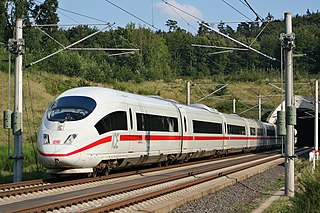
Intercity Express is a high-speed rail system in Germany. It also serves destinations in Austria, France, Belgium, Switzerland and the Netherlands as part of cross-border services. It is the flagship of the German state railway, Deutsche Bahn. ICE fares are fixed for station-to-station connections, on the grounds that the trains have a higher level of comfort. Travelling at speeds up to 320 km/h (200 mph), they are aimed at business travellers and long-distance commuters and marketed by Deutsche Bahn as an alternative to flights.
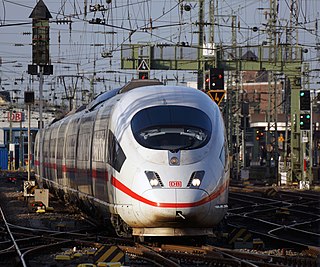
As of 2021, Germany had a railway network of 33,399 kilometres (20,753 mi), of which 20,540 kilometres (12,760 mi) were electrified and 18,556 kilometres (11,530 mi) were double track. Germany is a member of the International Union of Railways (UIC). The UIC Country Code for Germany is 80.

EuroCity (EC) is an international train category and brand for European inter-city trains that cross international borders and meet criteria covering comfort, speed, food service, and cleanliness. Each EC train is operated by more than one European Union or Swiss rail company, under a multilateral co-operative arrangement, and all EC trains link important European cities with each other.
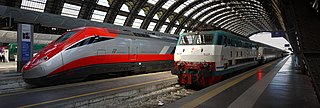
The Italian railway system is one of the most important parts of the infrastructure of Italy, with a total length of 24,227 km (15,054 mi) of which active lines are 16,723 km (10,391 mi). The network has recently grown with the construction of the new high-speed rail network. Italy is a member of the International Union of Railways (UIC). The UIC Country Code for Italy is 83.
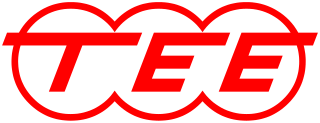
The Trans Europ Express, or Trans-Europe Express (TEE), was an international first-class railway service in western and central Europe that was founded in 1957 and ceased in 1995. At the height of its operations, in 1974, the TEE network comprised 45 trains, connecting 130 different cities, from Spain in the west to Austria in the east, and from Denmark to Southern Italy.

DB Fernverkehr AG is a semi-independent division of Deutsche Bahn that operates long-distance passenger trains in Germany. It was founded in 1999 in the second stage of the privatisation of Deutsche Bahn, under the name of DB Reise&Touristik and was renamed in 2003.

The Double-deck Coach is a bilevel passenger railcar currently manufactured by Alstom, which acquired Bombardier Transportation in 2021 used by various European railways and Israel Railways. The current generation of double-deck coaches can be run at speeds up to 200 km/h (125 mph). Depending on their configuration, each coach can seat 100 to 150 passengers.

City Night Line, abbreviated CNL, was a train category of German railway company Deutsche Bahn for overnight passenger train services between Germany and neighbouring European countries. In late 2015, Deutsche Bahn announced that it planned to terminate all night train services in December 2016, and this plan was implemented on 11 December 2016. The service on some CNL routes was replaced by ÖBB Nightjet services.

Railteam B.V. is a closed company with limited liability (B.V.) based in Amsterdam, the Netherlands. It operates as an alliance of European railway companies in the field of international high-speed rail in Europe, modelled on the airline alliances and was founded in Brussels on 2 July 2007.

The EuroSprinter family of electric locomotives is a modular concept of locomotives for the European market built by Siemens Mobility. The internal Siemens product name is ES 64, with ES for EuroSprinter and the number 64 indicating the 6,400 kW power at rail.

Railjet is a high-speed rail service in Europe operated by Austrian Federal Railways (ÖBB) and Czech Railways (ČD). Branded as Railjet Express (RJX) for the fastest services and as Railjet (RJ) for services with additional stops, it was introduced in 2008 and operates at speeds of up to 230 km/h (143 mph). Railjet is ÖBB's premier service and operates both domestically within Austria and on international services to adjacent major cities in the Czech Republic, Germany, Switzerland, Italy, Hungary and Slovakia.

A motorail train or accompanied car train (ACT) is a passenger train on which passengers can take their car or automobile along with them on their journey. Passengers are carried in normal passenger carriages or in sleeping carriages on longer journeys, while the cars are loaded into autoracks, car-carriers, or flatcars that normally form part of the same train.
Railway companies in Europe assign their trains to different categories or train types depending on their role. Passenger trains may be broadly split into long-distance and local trains; the latter having average journey times of under an hour and a range of less than 50 kilometres. Goods trains have their own train types. The names of these train types have changed continually over the course of time.

Bolzano/Bozen railway station is the main station of Bolzano/Bozen, capital of the autonomous province of Alto Adige/Südtirol, in northeastern Italy.
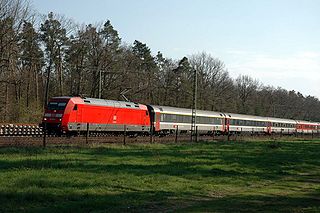
The German rail network provides connections to each of its neighbouring countries, many of which are under the EuroCity classification. EuroCity services are part of the Intercity network - many EC services represented a couple of train pairs on an IC route extended across the border, while other routes are served primarily by EuroCity services. EuroCity services are generally locomotive-hauled, using Intercity rolling stock, either from Deutsche Bahn or one of the other countries along the route.
Mozart was an express train that linked Paris with Vienna via Strasbourg, Stuttgart and Munich. The service began in 1954, as an F-Zug named Mozart Express running between Strasbourg and Salzburg, before being extended ten years later. In 1983 it was re-classified as an FD-Zug and it was added to the EuroCity network in 1989. It operated until 2007, when it was replaced by a TGV service on the newly opened LGV Est. It was named after the composer Wolfgang Amadeus Mozart, and served many cities with which he had an association.

The Polonia is a EuroCity (EC) express train. It was introduced in 1997, to supplement the existing EuroCity train, the Sobieski, on the international route between Vienna, the capital of Austria, and Warsaw, the capital of Poland, via the Czech Republic.

The Komet was an international overnight express train service between Germany and Switzerland, which was in operation from 1954 to 2016. Its name reflected the notion that the Comet train and an actual comet can both be described as travelling through the night at high speed. It was introduced in 1954. It became a EuroCity (EC) service upon the launch of the EC network in 1987. It became categorised as CityNightLine (CNL) service in the mid-1990s. With the decision by Deutsche Bahn to terminate all CNL services in December 2016, the Komet ran for the last time on 10–11 December 2016.

Nightjet is a brand name given by the Austrian Federal Railways (ÖBB) to its overnight passenger train services.


















